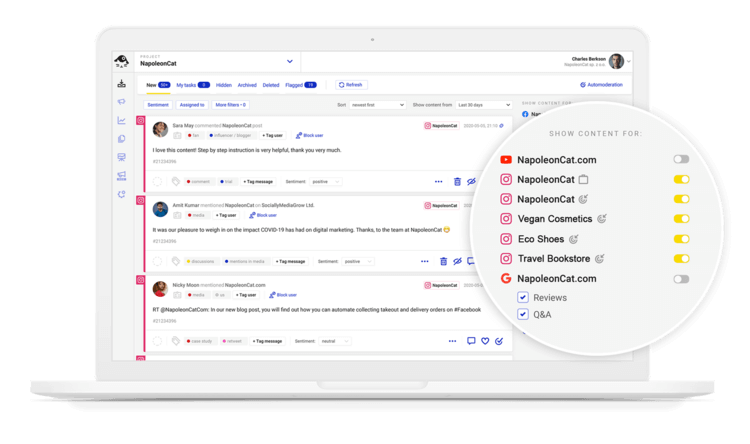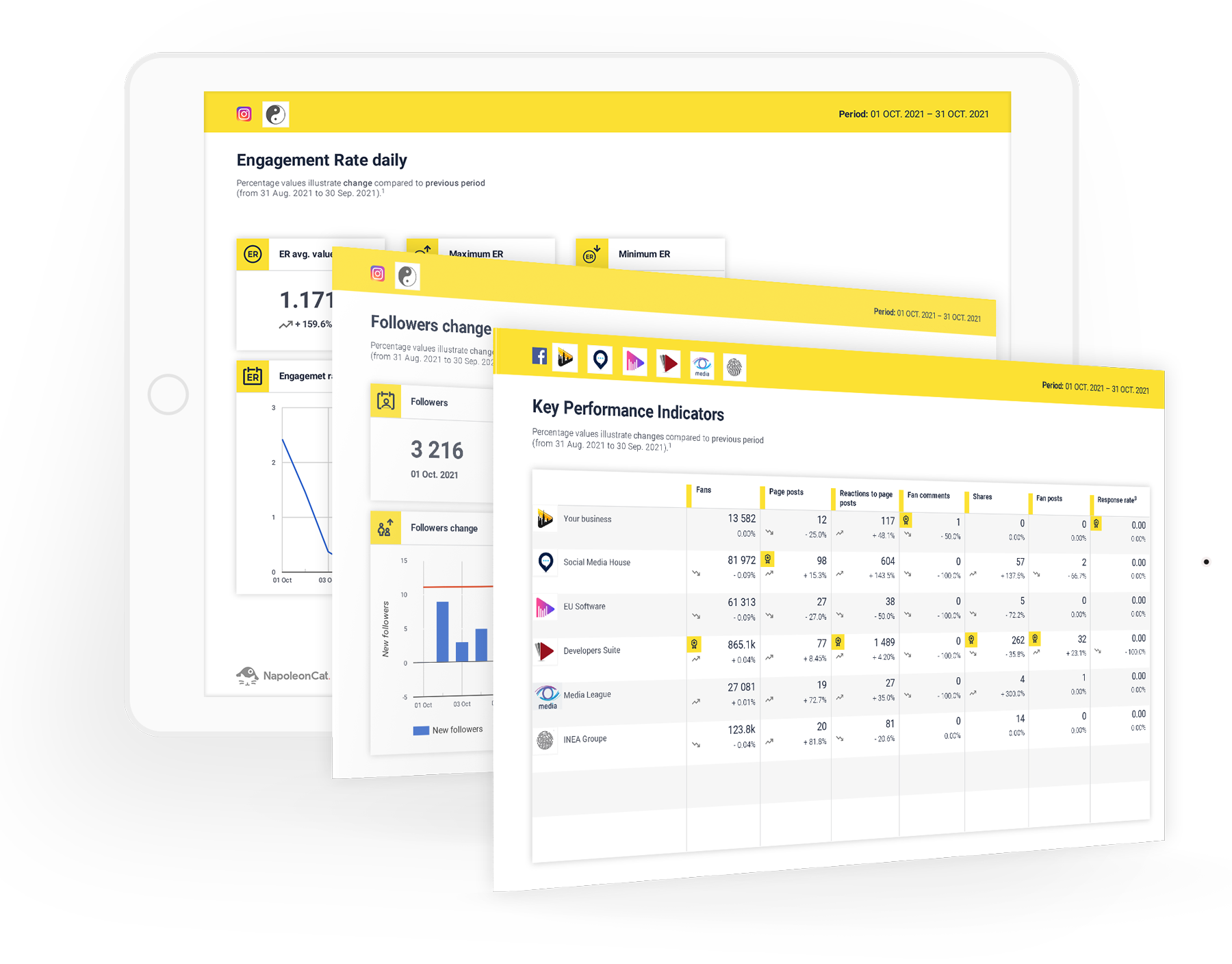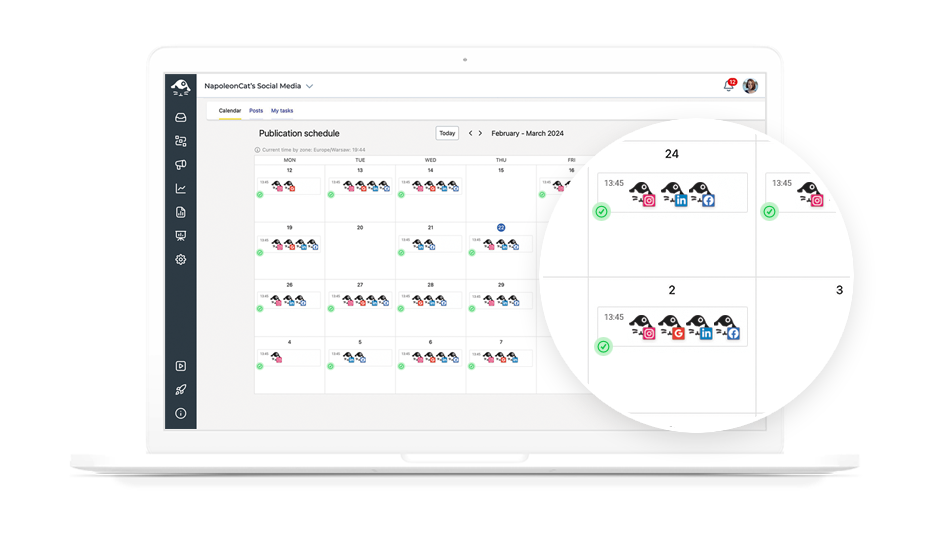Table of Contents
Trying to come up with content ideas for social media campaigns can be fun… until it’s not.
Because let’s face it: No matter how eager you are to share your ideas with the world, it’s only a matter of time before your creative juices run dry.
Here’s a dose of reality: The problem isn’t that you have no content ideas – it’s that you don’t have content pillars that serve as your foundation for coming up with content ideas for social media campaigns.
What are the content pillars for social media? And how do they help you develop content ideas that serve your social media content strategy? More importantly, how do you create effective content pillars that align with your goals and resonate with your audience?

Simplify Social Media
Management with One Tool
- Manage & reply to comments and DMs in one place.
- Monitor ad comments from multiple accounts.
- Automate answers to repetitive questions.
- Schedule posts to multiple accounts, on desktop.
- Analyze performance and monitor hashtags.
- Keep track of your competition.
- Create or schedule in-depth reports in seconds.
What are the content pillars for social media?
Content pillars for social media are the broad topics that support or reinforce the main idea or purpose behind your brand’s social media presence.
For example, if you’re publishing content for a travel agency via Instagram, your social media content pillars could be destination guides, travel tips, cultural insights, and customer testimonials.
Put another way, content pillars are the overarching themes that form the connective tissue of your brand story.
The operative term here is “connective tissue” since content pillars enable you to give your social media campaigns a cohesive narrative that grabs and holds the attention of your target audience.
The ideal number of content pillars is three to five. Having too many content pillars can make your social media marketing efforts unfocused. If they are too few, your content campaigns won’t have the thematic range to support your brand story and business goals.
You can think of content pillars as content categories to inform your social media content strategy, with each category having its own subcategories and subtopics.
But no matter how specific you get in your subcategories, they must tie back to a theme and support your overall brand message (more on that in a bit).
Why are content pillars important for social media?
Simply put, content pillars for social media put you in an ideal position to create content your target audience will love or respond to.
You can think of content pillars as guideposts that help focus your content creation efforts, especially if they align with your business goals and serve your target audience.
Instead of throwing ideas at the wall and waiting to see what sticks, you can rest easy that every content you publish will grab and hold your audience’s attention, not to mention support your business goals.
Content pillars also help save time. Brainstorming content ideas is a timesuck. Yes, some days are easier than others. But if you’ve been doing this long enough, there will be days when you hit a creative brick wall.

By defining broad themes that inform your content strategy, you have a deep well (or wells) to draw from. With established content pillars, brainstorming sessions are more focused. There is no need to start from scratch because you can look at your categories and quickly determine what you’ve already covered and what else needs to be covered.

Protect your social media from trolls
Automatically hide or delete comments from Facebook and Instagram trolls under your organic posts and ads, for all your profiles at once – with an all-in-one social media tool.
Content pillars vs. brand pillars
Before we get deeper into the topic. Here’s an important reminder: content pillars are different from brand pillars.
Brand pillars are the principles and values defining your brand. In other words, they are foundational elements shaping your brand strategy.
Typically, core brand pillars include purpose, perception, identity, values, and brand experience. Still, you can add more depending on how you want to differentiate your brand from competitors.
Simply put, brand pillars inform your branding efforts, specifically your brand’s tone and voice (but that’s a topic for another day). Whereas content pillars inform your content strategy (or social media content strategy).
Content and brand pillars are not the same, but they work together to shape your brand identity and how you create content.
Examples of content pillars
To create content pillars that work for your brand and speak to your audience, it helps to examine how other brands have pulled it off.
The following brands built a solid social media presence by defining content pillars that supported their content creation efforts.
Patagonia
Patagonia is an outdoor clothing brand that has established a solid reputation for high-quality recycled clothing and, most of all, for embracing sustainability, environmental activism, and social responsibility.
Even a quick glance at Patagonia’s Instagram profile reveals that the outdoor clothing company’s posts encompass these themes.
From posts featuring outdoor adventures to community initiatives and the ‘Don’t Buy This Jacket’ post, Patagonia demonstrates that it will not compromise its ideals for profit. What’s ironic is that it increased the brand’s profits anyway. With 5.4 million followers and counting, Patagonia’s social media presence continues to loom large.

HubSpot
As a cloud-based CRM provider, HubSpot is already a household name among marketers, sales professionals, and customer service reps.
And for good reason. HubSpot has successfully built a loyal following by positioning itself as an authority in inbound marketing, sales, and customer service. From marketing reports to sales tips to business insights, HubSpot continues to publish social media content that keeps its target audience engaged.

Chipotle
Chipotle is a fast-casual restaurant chain renowned for its Mexican-inspired cuisine made with real, high-quality ingredients.
Thanks to its commitment to serving food with natural ingredients without preservatives, additives, and flavor enhancers, Chipotle became a favorite among health-conscious Gen Zers and millennials.
By sharing social media content that underscores the brand’s dedication to culinary craftsmanship, health and wellness, and sustainability, Chipotle continues to satisfy its target audience’s sensibilities and cravings.

How to identify content pillars for your brand on social media
Identifying content pillars for social media can get tricky, at least if you’re not following the proper steps.
Well, let’s fix that.
Here are the steps to take to identify your brand’s content pillars.
1. Define your content framework
Your content pillars will only hold if your social media content strategy has a solid framework to serve as a foundation (yep, same with building skyscrapers).
Creating a content framework helps you get a better sense of what types of content to publish.
Your content framework is comprised of three components, namely your:
- Mission
- Core message
- Core themes
Define your mission
Before publishing on social media, you must identify and articulate why your brand exists and how it benefits your target audience.
This is no kumbaya talk. By identifying your brand’s WHY, you give yourself a clear direction and purpose for your social media content.
When every piece of content fulfills your brand mission, you give your target audience a good reason to consume every piece of content you put out.
To identify your brand’s core mission, ask yourself:
- Why does your brand exist?
- What problem does it solve?
- How does your brand benefit your target audience?
- What sets you apart from your competitors?
Once you’ve answered the above questions, you’re in a better position and headspace to craft your brand’s mission statement.

Track Competitors' Brands on Social Media
Find out what content works best for your competitors and when exactly it generates the highest engagement. Get competitive analytics for Facebook, Instagram, and YouTube – with an all-in-one social media tool.
Write your core message
Once you’ve written down your brand mission, it will be easier to craft your brand’s core message.
To craft your core message, state what your brand stands for and how it uniquely benefits your audience.
Identify your core themes
Next, write down the core themes supporting your mission and message. Try to come up with seven if you can. Think of these core themes as the essential topics that will guide your target audience toward the benefit or solution they seek and that you can provide.
This list is not final. As you gain more data, you’ll have to narrow your core themes down to three or five, but for now, you can use these core themes as starting points.
Here’s an example of how this works:
Mission: Equip aspiring entrepreneurs with the knowledge to launch successful online businesses.
Core message: Every aspiring entrepreneur deserves to pursue their passion and achieve financial independence.
Core themes: Entrepreneurship, financial independence, skill development, community building, marketing strategies, innovation and technology, leadership
2. Get to know your target audience
Now that you have a better grasp of what you want your brand to accomplish when publishing content, you need to understand your ideal readers better.
Why? Without knowing your audience’s goals, pain points, and motivations, you’ll end up creating social media content they won’t care about.
The most common mistake marketers make is assuming they understand their target audience. Remember: what you consider “good” content may not be what your ideal readers will consider good.
But what do you need to learn about your ideal readers to find out what types of social content they will like?
To understand your target audience, you can:
- Interview your most loyal customers
- Conduct surveys
- Gather insights from your sales teams
- Gather analytics data using audience insights via your social media profiles
It helps to use a multi-pronged approach to getting to know your audience. That said, some trial and error via social media analytics helps. By tracking key metrics before and after you share each piece of content, you can paint a clear picture of what they want to see from your brand when they spot your content in their social media feeds.
Using NapoleonCat’s social media analytics tool, for example, helps you access in-depth, relevant stats across social media channels for multiple accounts and pages using a single dashboard.

While you measure and analyze your key metrics, note that the social media posts are performing well. What are they about? What themes do they cover? What captions or visuals did you use? Track their activity and get spot-on insights about your target audience.
Use the above methods to gather your data. You’ll be surprised at how much you can learn about your ideal readers and how these insights can help you identify your content pillars later.
3. Perform a content gap analysis
You now have a well-established content framework. You also know your target audience well enough to start calling them your BFFs. Does that mean you’re ready to develop your content pillars for social media?
Almost, but not quite.
Given how modern customers are navigating a complex digital landscape, chances are there are still some concerns, questions, and objections you still need to account for. Heck, even customers need to figure out what they want and need most of the time. As a social media marketer, it’s your job to discover those gaps.
Because if you want to position your brand as an authority in your niche, you need to address these gaps. And you can do that with a content gap analysis.
To ensure you cover all bases, you need to approach your analysis from two angles: via your existing content and the content of your competitors.
And this means doing the following:
- Conducting a content audit
- Performing a competitor analysis
How to conduct a content audit
Start reviewing all your existing social media content across platforms. Evaluate each piece to determine its performance, relevance to your audience, and alignment with your brand message and core themes.
Can you identify which content pieces resonate with your audience and which ones fall short?
If you’re dreading the idea of creating spreadsheets, you’ll be happy to know that NapoleonCat’s social media analytics tool can help you create social media reports and generate actionable insights that will help you inform your content pillars and your social media content strategy.
How to perform a competitor analysis
Next, you need to analyze your competitors’ social media presence (yes, we’re spying, and that’s okay).
The goal here is to compare your social media content to that of your competitors and identify areas where you are lagging and where you can set yourself apart.
Once you’ve identified your competitors (performing Google searches using keywords your target audience searches for helps), you can check out their social media accounts to see which topics they’re covering, their approach to branding, and how they’re engaging with their following.
By gathering data and insights from your competitors, you can benchmark your business against them and, in the process, identify topics and themes you may have missed.
We highly recommend you test NapoleonCat completely for free – no credit card required 😉

Track Competitors' Brands on Social Media
Find out what content works best for your competitors and when exactly it generates the highest engagement. Get competitive analytics for Facebook, Instagram, and YouTube – with an all-in-one social media tool.
4. Craft your content pillars for social media
After performing the above steps, you will have gathered more than enough data to generate insights that will help you identify and craft your content pillars.
By this point, you can identify common themes and patterns that will guide your content creation efforts. Also, synthesize your findings and see if there are hidden connections that may generate insights that will give you an edge over your competition.
And since they’re aligned with your brand mission and tailored to the needs and desires of your target audience, you’ll be more confident that your posts – or at least most of them – are inching you closer to reaching your business goals.
Again, aim for 3-5 content pillars. That way, your content categories are broad enough to make your posts diverse and specific enough to keep your content focused.
Say you’re creating content for a cloud service provider. Your content pillars could be cloud technology advancements, customer case studies, security best practices, tutorials and how-tos, and industry news and trends.
5. Create your subtopics and subcategories
You need to give your content pillars thematic depth and diversity to have a bigger impact on your target audience and business goals. To pull this off, create subtopics for each content pillar.
For example, for the content pillar “Cloud Technology Advancements,” you can create subtopics such as machine learning innovations, advanced cloud storage solutions, and future trends in cloud computing.
There are many ways to share an idea or prove a point, so diversify your content format. To do this, create subcategories (based on format) for each content pillar.
For example, if you want to create a content strategy on Facebook, you can create subcategories for each pillar, such as text posts, image posts, video posts, and live videos. If you’re publishing on multiple social media channels, you can create a subcategory for each.
Bonus step: Plan, create, and schedule your content calendar
Once you’ve identified your content pillars, you can start brainstorming content ideas and creating content.
Obviously, this is the toughest and most time-consuming part — especially if you’re managing multiple social media profiles and publishing across multiple social media channels.
To streamline your content creation efforts and save time, schedule your social media posts in advance. If you’re finding it hard to stay on schedule, try grouping similar tasks together and finishing them in focused blocks of time (also called content batching).
Once you’ve planned your posts, make sure to plot them in a content calendar.
You can create a content calendar using a Google spreadsheet. Simply create columns for the social media platform, the title or topic, the contents of your post, the date, the category/label, and more.
Not a spreadsheet person (you and me both)?
Thankfully, a social media publishing tool enables you to automatically publish your content from different social media accounts (if you have many) across multiple social media platforms using one calendar. That includes TikTok, X (Twitter), Facebook, Instagram, LinkedIn, and even Google My Business.

That means each piece of content can be plotted and managed in one calendar. You can also assign specific tasks to each member of your social media team (if you have one) so they’ll be able to see what’s in the pipeline.
But what about the content pillars we just talked about? Where do they fit in?
When organizing your content with the calendar, you can use color-coded labels to organize your content into different campaigns, channels, and, yes, content pillars. That way, you can see every aspect of your entire social media strategy at first glance.

You can see how it works in this video:
Final thoughts: How to use content pillars for social media success
To steer your social media campaigns in the right direction, you need content pillars to serve as guideposts as you work to build a social media presence.
With well-defined content pillars, you can confidently navigate the evolving landscape of social media, knowing that each piece of content you create serves a purpose and contributes to your overall goals.

Simplify Social Media
Management with One Tool
- Manage & reply to comments and DMs in one place.
- Monitor ad comments from multiple accounts.
- Automate answers to repetitive questions.
- Schedule posts to multiple accounts, on desktop.
- Analyze performance and monitor hashtags.
- Keep track of your competition.
- Create or schedule in-depth reports in seconds.
You may also like:
- How to Create Thumb-Stopping Social Media Hooks + 10 Examples
- KOLs in Marketing: Who They Are & How to Partner
- Top 10 YouTube Influencers To Follow
- The 8 Best Marketing YouTube Channels To Follow
- Your Best Guide to Social Media Publishing
- 13 Free and Paid Social Media Scheduling Tools for Teams
- What’s a Social Media Scheduler, and Why Do You Need One?


